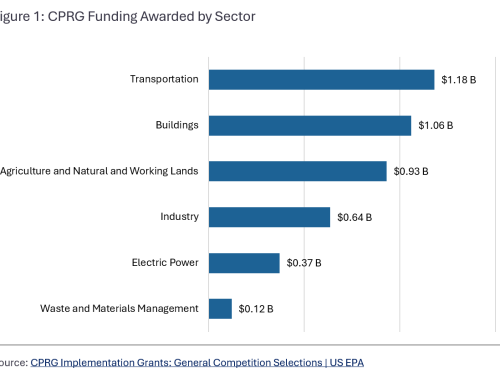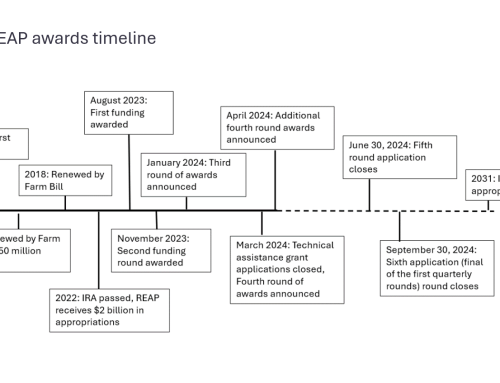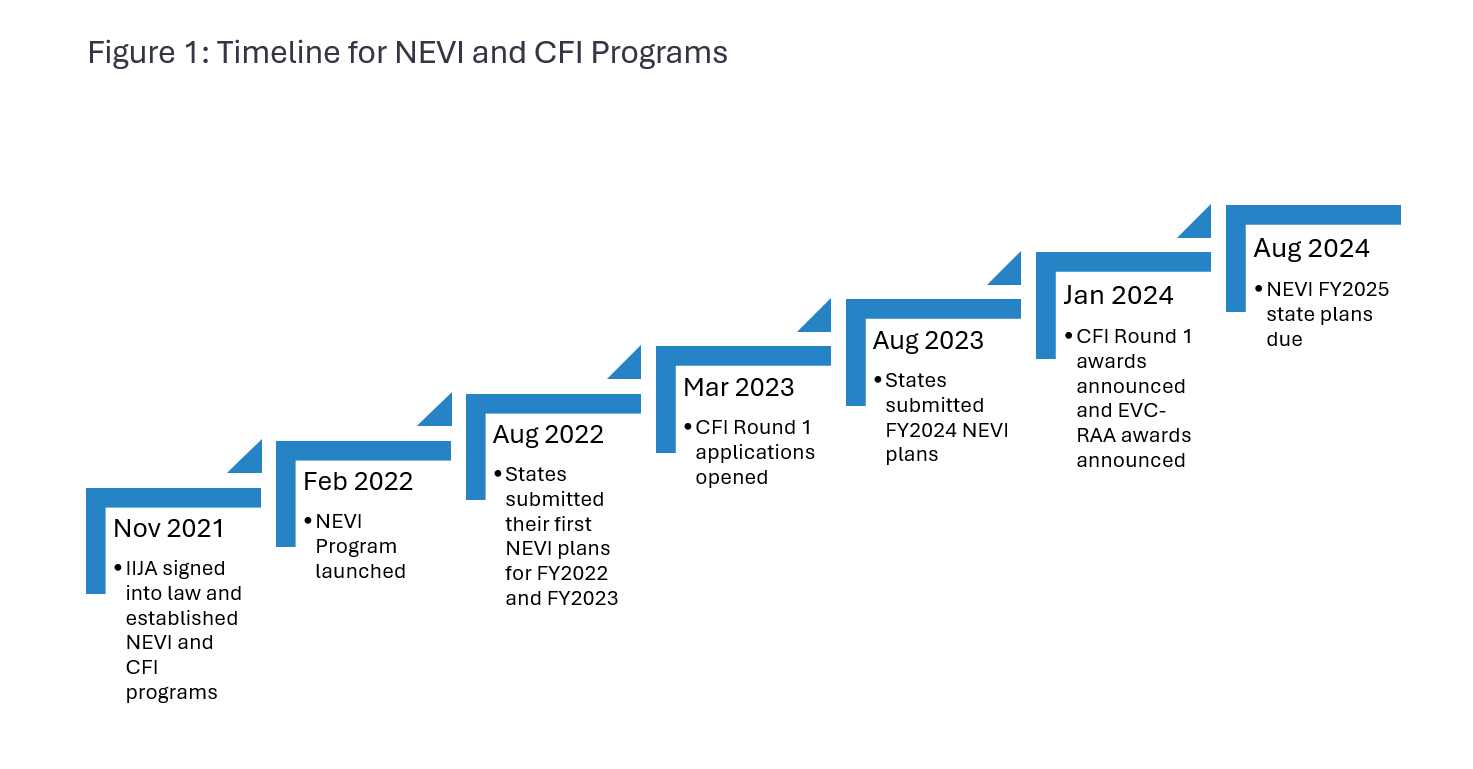
By: Jaclyn Lea and Sophie Latham
The Infrastructure Investment and Jobs Act (IIJA) earmarks $7.5 billion over five years to build a nationwide network of electric vehicle (EV) chargers. The funding is allocated across three major EV charging programs administered by the U.S. Department of Transportation’s (DOT) Federal Highway Administration (FHWA). These programs include $5 billion for the National Electric Vehicle Infrastructure (NEVI) Formula Program (of which 10 percent is set aside for the EV Charger Reliability and Accessibility Accelerator) and $2.5 billion for the Charging and Fueling Infrastructure (CFI) Discretionary Grant Program. Read on for analysis of the funding awarded so far.
NEVI PROGRAM
The National Electric Vehicle Infrastructure Program (NEVI) sets aside $5 billion over five years, through fiscal year 2026, for EV charging equipment installation. Of this, $2.5 billion has been released so far in fiscal years 2022, 2023, and 2024. The money comes from the FHWA and is administered by the states. The goal of the program is to create national charging corridors, particularly along major highways, with the eventual wider goal of 500,000 chargers installed across the United States.
States must submit a plan to the FHWA each August describing how they will use NEVI-allocated funds in compliance with the program’s standards, and funds become available to states once approved by the FHWA. All 50 states, plus Washington D.C. and Puerto Rico, have submitted plans and received approval for all three rounds of funding so far.
More than half of states have already begun implementing funds through the NEVI program. To date, 32 states have either solicited proposals from private contractors via a competitive process or directly contracted with vendors to install NEVI-funded public fast chargers.
Moreover, 16 states have issued awards from their first rounds, for a total of just above $170 million distributed to contractors. Most of these states have issued funds through Requests for Proposal (RFP), which splits funds between contractors through a competitive process. Alternatively, some states have opted to issue initial funding through a direct contract with a sole vendor, including Hawaii, Vermont, and New York. In Vermont, the state is choosing to upgrade an existing site to accommodate NEVI standards before opening a competitive grant application for new construction. In Hawaii, the state has contracted with one operator, Sustainability Partners, and one hardware supplier, Tritium, for their entire network. New York has contracted solely with New York Power Authority for the first round of funding, meanwhile, Colorado, Maine, Pennsylvania, and Ohio have moved on to opening solicitations for the second round of funding. Some states have broken ground, with construction underway and a few NEVI chargers now open to the public in New York, Ohio, and Pennsylvania.
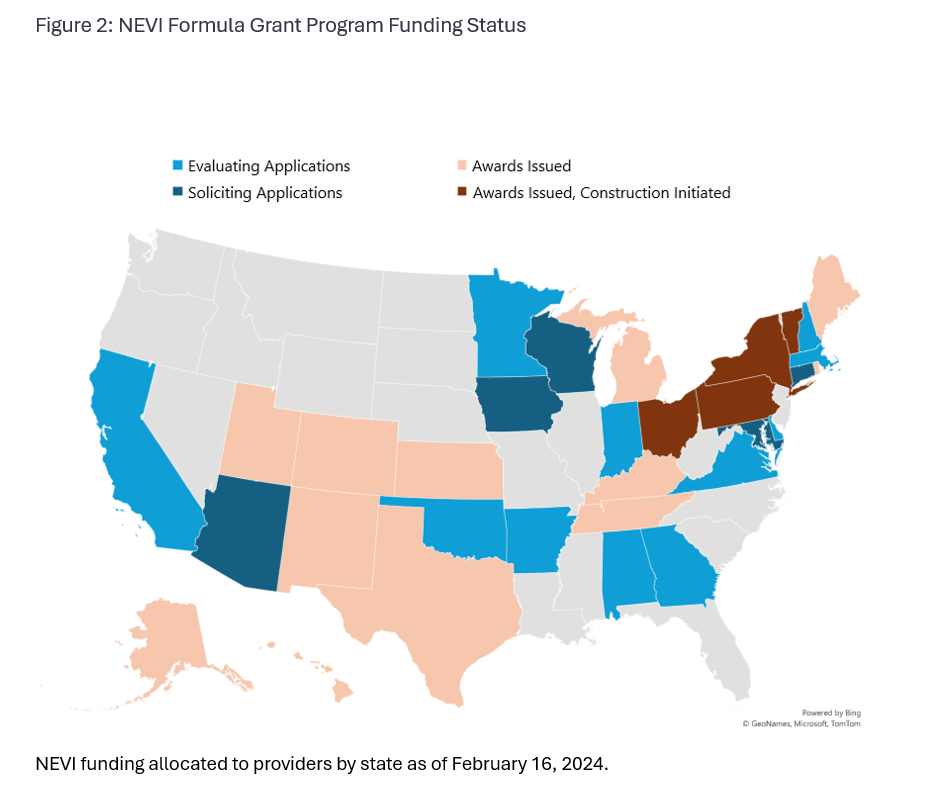
While the NEVI program prioritizes new and reliable EV charging infrastructure, the program also sets aside funds to repair and replace existing non-operational chargers or upgrade them to meet NEVI standards. Ten percent of NEVI funds are set aside as discretionary, separate from the state formula grant program, for the DOT to assign where it is needed through The Electric Vehicle Charger Reliability and Accessibility Accelerator. Funding opportunities will continue through FY2026 in parallel with the NEVI program. This funding is distributed differently, with state and local agencies applying for federal funds and then separately contracting with providers.
The first round of the accelerator awarded $149 million of this discretionary money. As this funding is for upgrading chargers, state, and local governments with longer histories of EV adoption are more likely to need it. California was the largest beneficiary of this funding round garnering 43 percent of all funds. The state received $64 million for 1,302 charging ports at 300 sites. The next highest award, at $13 million, went to New York for 335 charger upgrades.
The NEVI formula grants will continue to be released until FY2026, while the remainder of the discretionary fund has not yet been earmarked for future use.
CFI PROGRAM
The Charging and Fueling Infrastructure (CFI) Discretionary Grant Program provides $2.5 billion in funding over five years for publicly accessible electric vehicle charging infrastructure, hydrogen fueling infrastructure, propane fueling infrastructure (for medium- and heavy-duty (MDHD) vehicles only), and natural gas fueling infrastructure. Priority is given to rural areas, low- and moderate-income neighborhoods, and communities with low rates of private parking. The CFI Program is comprised of two tracks: Community Charging and Corridor Charging. The Community Charging grants prioritize charging infrastructure in underserved and lower income communities while the Corridor Charging grants are available to deploy infrastructure along designated Alternative Fuel Corridors (AFCs).
On January 11, 2024, the Biden Administration announced $623 million in awards for the first round of funding under the CFI Program. The funding will support 47 charging and fueling infrastructure projects in 22 states and Puerto Rico and facilitate the construction of 7,500 EV charging ports. This includes $311 million to support 36 community projects, including for two Tribes in Alaska and Arizona, and $312 million to support corridor projects.
While NEVI is specifically geared towards funding EV charging, the CFI program can fund a variety of project types including hydrogen and other alternative fuels. In this initial funding round, 84 percent of CFI funding went to EV charging projects while the remaining 16 percent went to hydrogen fueling projects. Three hydrogen projects went to the corridor track and one hydrogen project went to the community track. The CFI program is valuable because it allows governments to fill in critical charging gaps in underserved and disadvantaged communities.
Additionally, 70 percent of the CFI funding will go to project sites in disadvantaged communities. One of the grantees – the city of Mesa, Arizona – will increase the number of charging stations in disadvantaged communities by 167 percent. Over on the East Coast, the Maryland Clean Energy Center will receive $15 million to fund 58 EV charging stations statewide. It will also include over 34 community sites located in disadvantaged communities to be installed in multi-unit complexes, a critical EV charging challenge.
The two states that received the largest funding awards were California and Texas, each with a respective allocation of $169 million and $100 million (see Table 1). Together, both states make up 43 percent of total funding awarded. The San Joaquin Valley in California got more funding than any other state except Texas and California. The San Joaquin Valley Unified Air Pollution Control District received $56 million to build two electric truck charging sites in Taft and Gustine, California. The San Joaquin Council of Governments received $15 million to install 74 Level-2 and 40 DC fast chargers at 20 locations countywide. The North Central Texas Council of Governments (NCTCOG) received $70 million to build up to five hydrogen fueling stations for MDHD vehicles in the Texas Triangle, which includes Dallas-Fort Worth, Houston, Austin, and San Antonio. The NCTCOG also received $15 million to install up to 100 charging ports at publicly accessible EV charging stations throughout 16 counties in the Dallas-Fort Worth region. This funding builds on existing, though limited, funding for clean MDHD vehicles in Texas.
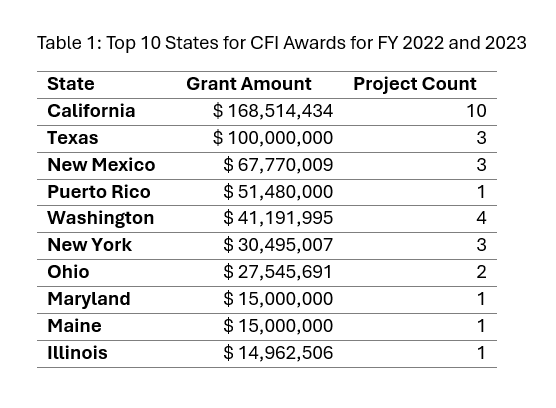
WHAT TO EXPECT IN 2024
The United States continues to make significant strides in EV charging deployment and transportation electrification. In January 2024, the Biden Administration confirmed the eligibility of approximately two thirds of Americans for the 30C EV charging tax credit established by the Inflation Reduction Act. This tax credit “provides up to 30% off the cost of the charger to individuals and businesses in low-income communities and non-urban areas.” Later in January, the Biden Administration vetoed a Republican measure to repeal a waiver that allowed “federally funded EV chargers to be made from imported iron and steel, as long as they are assembled in the United States.” According to President Biden, this would have hindered efforts to increase domestic manufacturing.
The NEVI and CFI programs will continue to roll out funding over the next couple of months. NEVI has made available almost 60 percent of its formula funding, leaving approximately $2 billion for the remaining two fiscal years. States are moving at very different paces to award funding and begin construction, which allows for lessons learned across different states’ experiences but can also create challenges for drivers as the national charging network develops at varying paces. Round two of the CFI program is expected to launch sometime in spring 2024. While specific details have not yet been released, we can expect to see continued focus on rural and disadvantaged communities and emphasis on workforce development and community engagement.
We will continue to track funding requests on our Opportunities Dashboard and the awards and outcomes on the Outcomes Dashboard.

